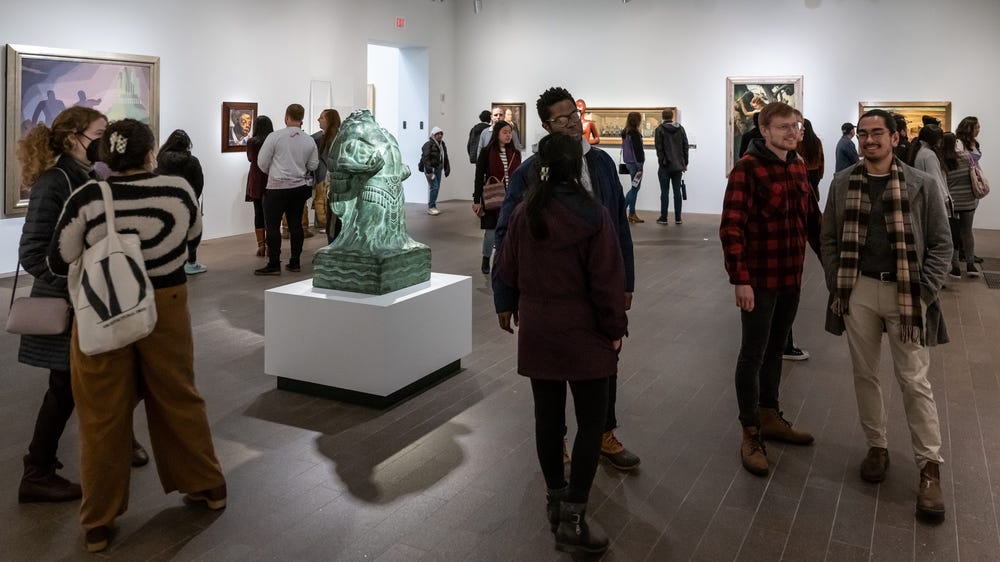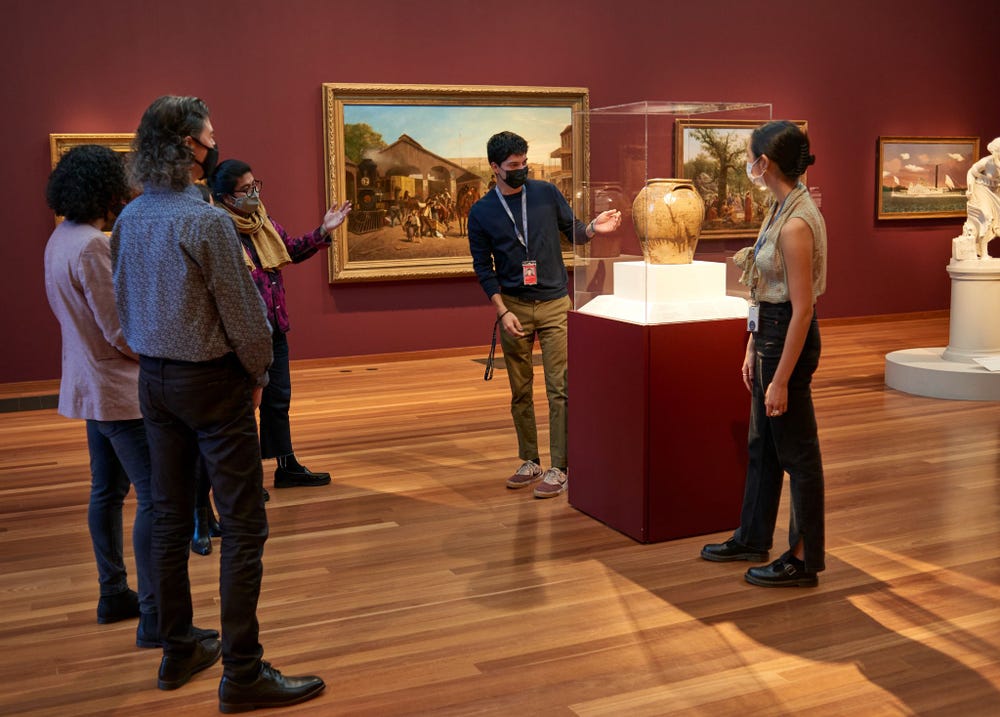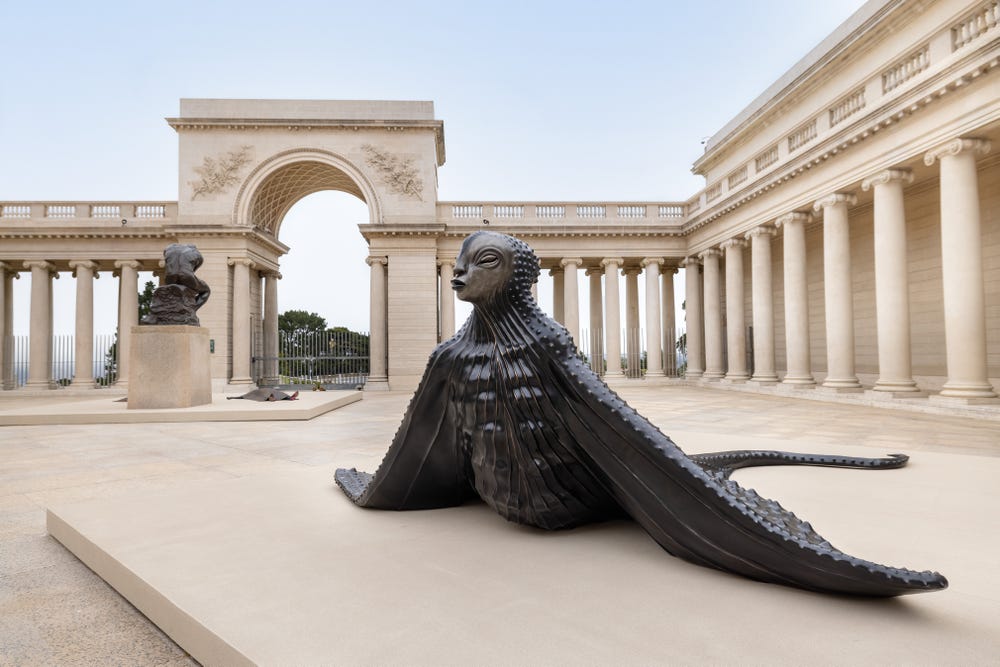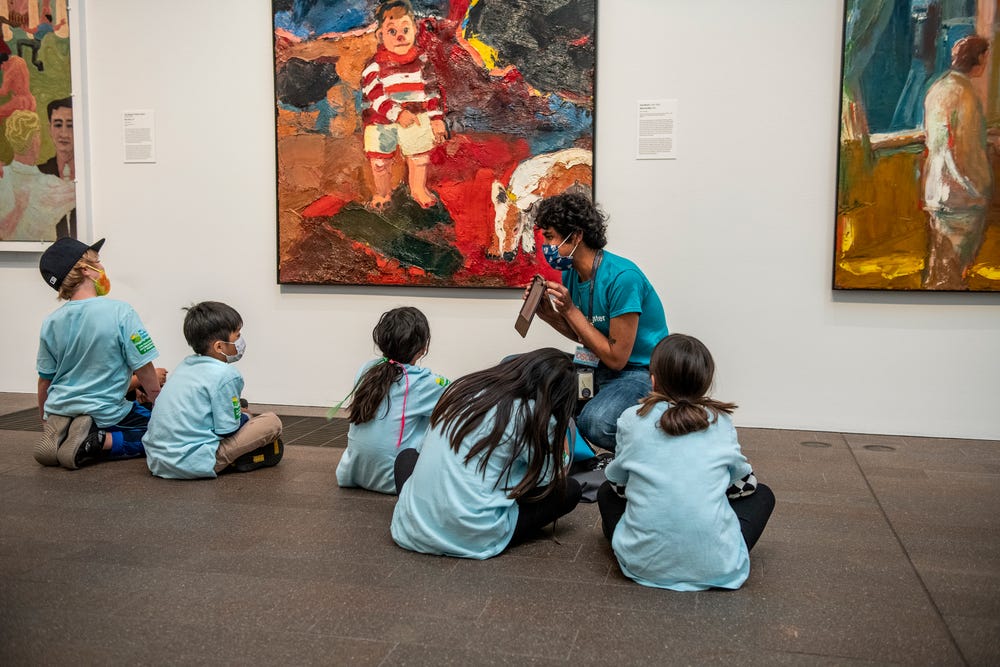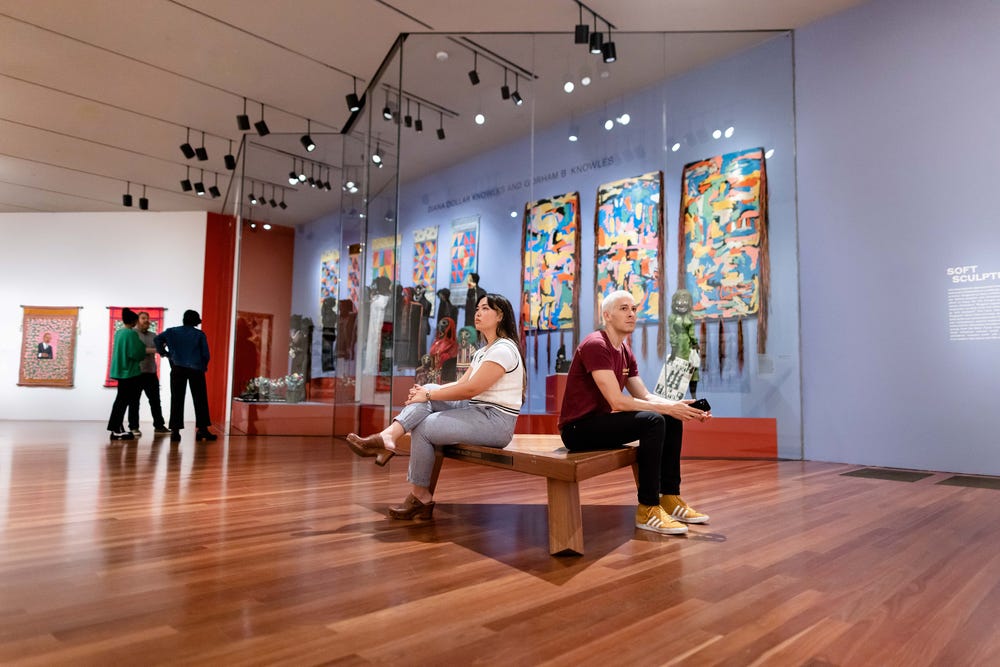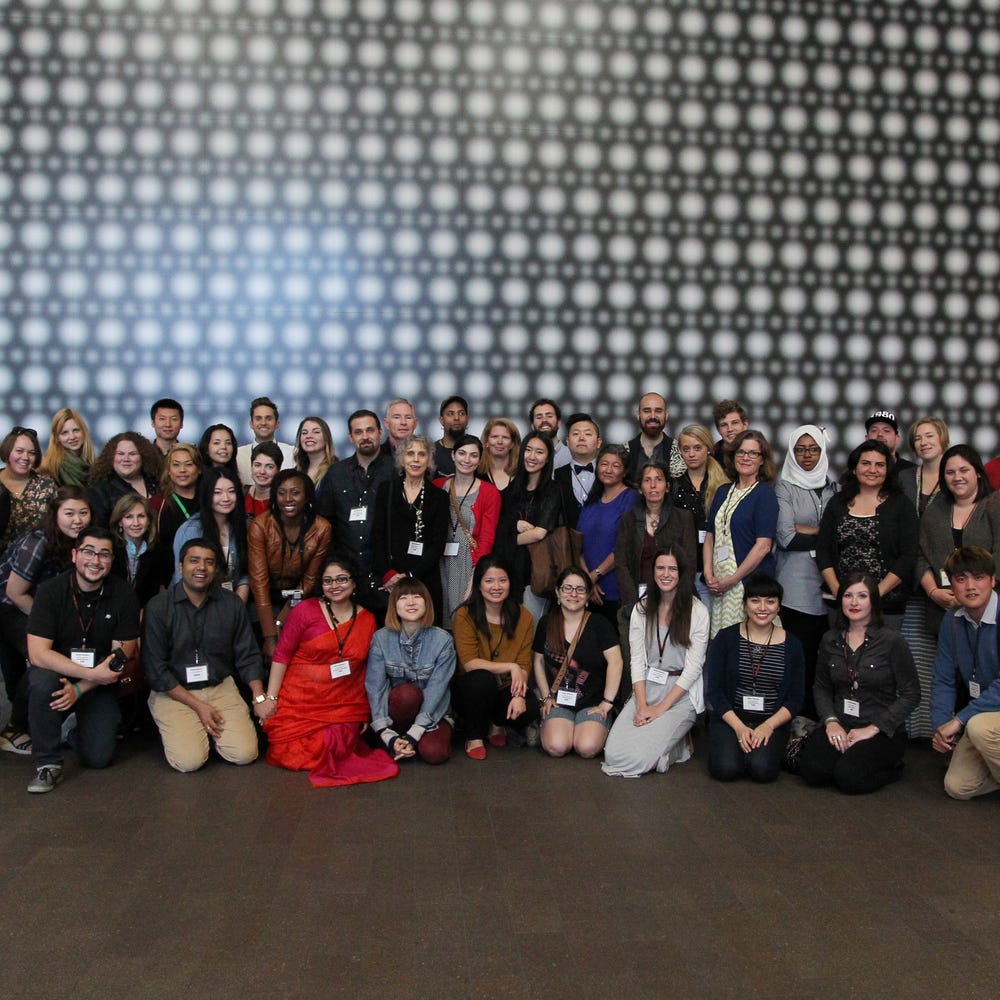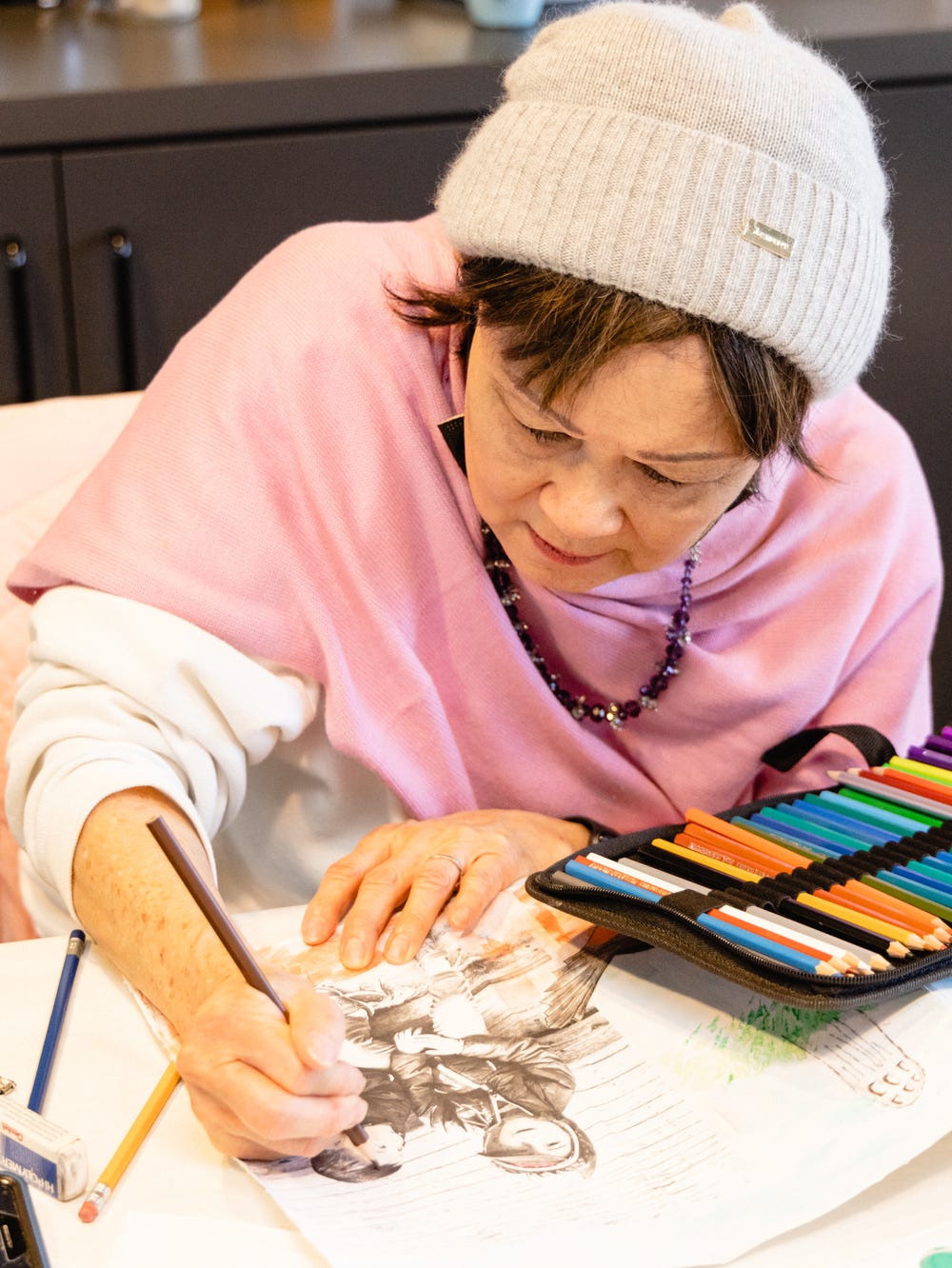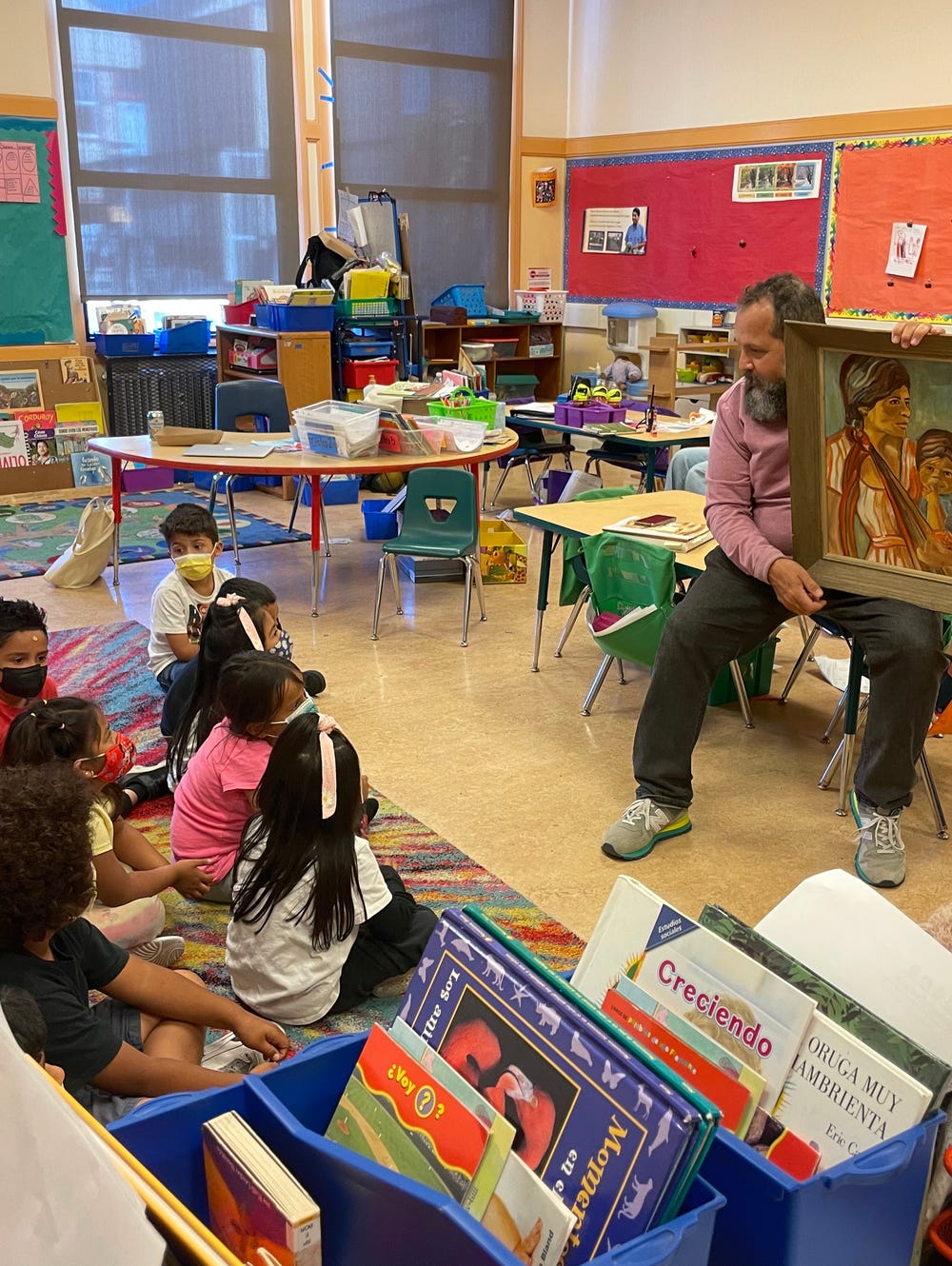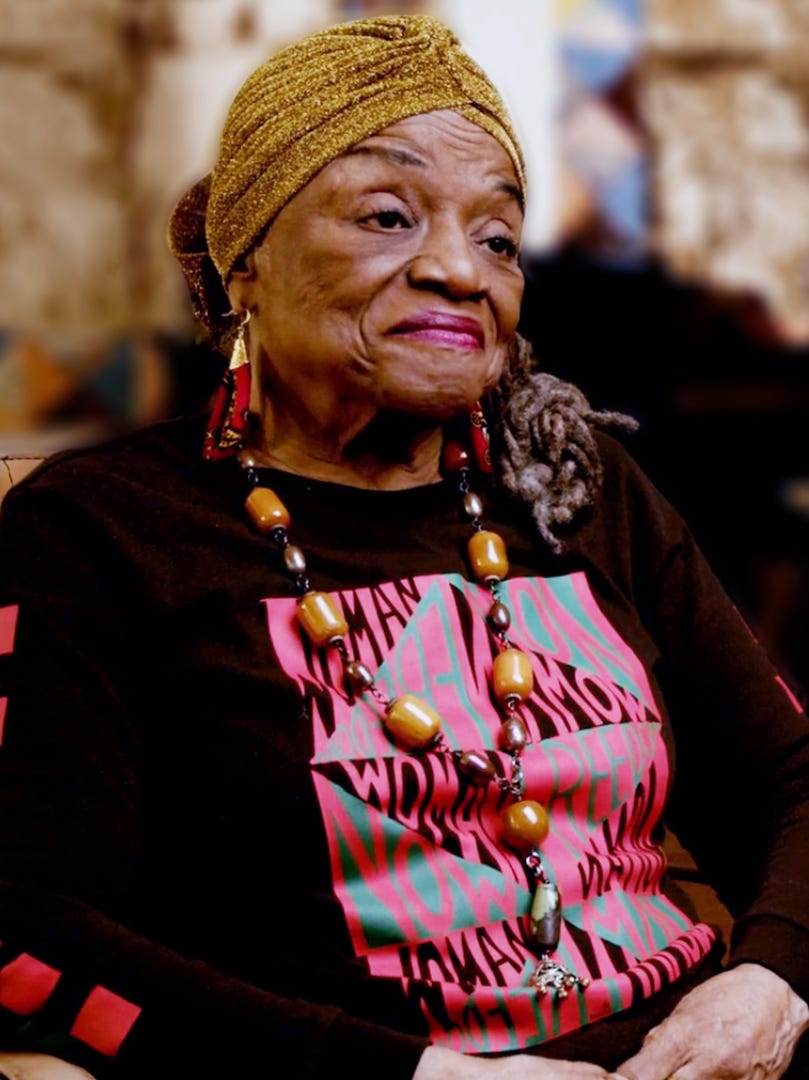Visitors enjoying Free Saturdays at the de Young. Photograph by Adam Jacobs
In 2020, amidst the backdrop of the pandemic, the museum sector was challenged to confront its colonial origins and radically embrace diversity and inclusion. It is rare that an entire industry has the opportunity to fundamentally change its trajectory, yet here was a moment to reenvision the future of museums. Building on previous efforts within the Fine Arts Museums of San Francisco, and spurred by the racial awakening that followed George Floyd’s murder in May 2020, the ensuing months were a period of profound reflection at FAMSF, during which we grappled individually and collectively with the manifestations of systemic racism that existed within the organization. In this period, staff across the Museums took part in humbling and raw conversations with colleagues in which we discussed how FAMSF could authentically center the values of diversity, inclusion, equity, and access in our programming and workplace culture. In those discussions, I remember hope intermingled with anxiety — hope that FAMSF could move toward becoming an anti-racist institution, and anxiety about the gap that existed between our stated commitment and real, sustained action.
In November 2020, we shared our commitment to making FAMSF an anti-racist institution in a post that documented our changes in progress and aspirations for a more inclusive, diverse, and equitable future. Since then, staff have bridged the chasm between intention and action through thoughtful shifts, both big and small, at every level of the organization. Some of those shifts have been documented in a series of articles by changemakers across the Museums. I am writing at the beginning of this new year to reflect on the progress we’ve made in the five areas of focus we committed to in 2020 (collections, exhibitions, public programs, workplace, and board) and share insights on the next stages in our journey to become an anti-racist institution.
The presentation and development of our collections
The Museums regularly update collection-related didactic information as new research emerges. However, since 2020, we have pushed further by scrutinizing existing in-gallery texts for implicit bias, thinking critically about the narratives and histories we present and those that have been excluded. Benefitting from the perspectives of external subject matter experts, our new-generation labels speak more objectively and explicitly about the legacies of colonialism, imperialism, and racism imbued within our collections. Likewise the new texts reflect an intentional shift to center non-white histories that were previously absent or ancillary. Since members of our curatorial teams wrote about these efforts in depth in February 2021, the Museums’ interpretive work has deepened with the appointment of Abram Jackson, our first Director of Interpretation. Utilizing DEIA theories and practices, Abram partners with staff across the Museums, as well as communities represented in our collections and exhibitions, to create inclusive interpretive frameworks. In addition, he is developing new processes for interpretation to ensure we are considering the most equitable narrative possibilities for our didactic texts.
Interpretation and Outreach Associate leads a discussion of David Drake’s “Catination” Storage Jar, 1836, in the gallery of American art at the de Young. Photograph by Jorge Bachman
Diversifying the collection goes hand in hand with our interpretive work. Many of our country’s art museums — the de Young and Legion of Honor included — were established in the late 19th and early 20th centuries by white founders for white audiences, and our founding collections reflect that. In 2023 and beyond (indeed, in perpetuity) we have a great deal of work to do in ensuring that our collections reflect our institution’s values, and the communities we live in and serve. Over the past several years, we have doubled down on previous efforts to diversify the artists represented in our Museums by acquiring artworks that address gender, racial, and cultural inequities within the collection. Last year, a gift from the Svane Family Foundation enabled us to acquire 42 works by 30 Bay Area artists, the majority of whom are non-white. Among the many other recent acquisitions I could highlight here, I want to call particular attention to an extraordinary ceramic jar made by the 19th-century Black American artist and poet David Drake. Positioned prominently in our Civil War–era gallery at the de Young, this object allows us to center experiences related to American chattel slavery and the extraordinary work of art made by an enslaved man, both of which have been historically marginalized in museums.
With the launch of a newly redesigned, content-rich website last fall, we have a real opportunity to amplify our collections, and much of our interpretive work, online.
Exhibitions
With curators often investing years of research in museum exhibitions, they are among the most effective means of increasing awareness of artists. With this in mind, in my November 2020 article, I noted that it was a priority to elevate the work and legacies of traditionally marginalized artists (past and present) and underrepresented narratives as a regular part of our exhibition roster. In 2021, with our exhibition slate left with gaping holes caused by pandemic cancellations, we were compelled to rapidly rebuild the schedule. While this had its challenges, we seized the opportunity to focus our exhibition program almost exclusively on women artists and artists of color, with meaningful presentations of art by Frida Kahlo, Judy Chicago, Wangechi Mutu, Patrick Kelly, and Pomo artists, whose work was presented in Jules Tavernier and the Elem Pomo. We continued to build on this in 2022 by bringing Alice Neel and Faith Ringgold’s work, along with Amy Sherald and Kehinde Wiley’s iconic portraits of First Lady Michelle Obama and President Barack Obama, to West Coast audiences. Now as we work to build a long-lead exhibition schedule, diversity and inclusion remain top of mind, and these values have been baked into our exhibition proposal processes, and are core pillars in the interpretive frameworks mentioned above.
Wangechi Mutu, MamaRay, 2020. © Wangechi Mutu. All rights reserved. Courtesy the artist and Gladstone Gallery, New York and Brussels. Installation view of Wangechi Mutu: I Am Speaking, Are You Listening? Photograph by Gary Sexton
Looking forward, there is a lot to be excited about. Just last month, we inaugurated a new gallery dedicated to works on paper in the Legion of Honor and a new contemporary African Art program — both present us with opportunities to expand the stories and histories we share with our audiences.
Programs and community
While FAMSF has a long legacy of community engagement and innovative education programs, our Education team spent much of the past few years assessing, and in some cases reimagining, various initiatives and programs. With the launch of our Free Saturdays program in 2019 — providing free admission to our permanent collection and select exhibitions every Saturday throughout the year — we were able to eliminate an economic barrier for Bay Area community members wishing to visit the Museums. In tandem, our Public Programs team recognized Free Saturdays as a platform for inclusive programming. While this continues today, we are always looking for areas of growth. Case in point, this past year, Director of Public Programs and Community Engagement Devin Malone introduced a new proposal process designed to better align our exhibition programming and values. Likewise, through a reimagined paid gallery guide program, Education staff and Interpretation and Outreach Associates engage Free Saturday visitors in creative conversations focused on works in the de Young’s collections. Thinking specifically about how we might evolve our offerings for school-age children in the Bay Area, we formed new partnerships and recalibrated summer camp at the de Young. In addition, we piloted an entirely new program in 2022, the Equity School Partnership Project (ESPP), which provides resources and collaborates with youth, educators, and community-based organizations in historically under-resourced neighborhoods.This program is supported by yet another reimagined initiative — de Youngsters Day Out. In its newest iteration, de Youngsters Day Out is a free, family-focused block party that raises funds for ESPP through sponsorships.
An Interpretation and Outreach Associate engages a group of school-age children in discussion. Photograph by James Watkins, San Francisco Recreation and Park Department
Later this year, we will present the second iteration of the triennial de Young Open, a juried community art exhibition open to all. This institution-wide effort is a real source of pride within FAMSF and reflects the Museums’ ambition to engage with and uplift the Bay Area’s creative communities.
Our workplace and hiring practices
Even as we institute changes to our public-facing programs and initiatives, we know that the work we do to serve our communities must be rooted in internal change. In the midst of FAMSF’s anti-racism trainings with Be the Change, we recognized that while shifting our staff and leadership demographics would take time, there were substantive, immediate changes that could be made to our hiring and workplace practices. As documented in detail in August 2022, our small but mighty Human Resources team has made significant shifts to our hiring practices, including but not limited to: “updating current and new job descriptions with inclusive language, interrogating the educational requirements for certain positions, and in certain instances substituting professional experience for education requirements.” The Museums’ staff body (including civil service [City] and private, nonprofit [COFAM]) has grown more diverse over the past two years, and the institution is immeasurably stronger as a result. FAMSF, and our commitment to become an anti-racist institution, has also been strengthened by the creation of two new positions — the aforementioned Director of Interpretation in Education and the Manager of Diversity and Inclusion in HR. Since joining us in January 2022, Courtney Jones, our inaugural Manager of Diversity and Inclusion, has brought structure and deep knowledge, helping scale and strengthen our work across operations, programming, and collections.
Installation view of Faith Ringgold: American People, de Young museum, San Francisco, 2022. Photograph by Gary Sexton
In the coming months, FAMSF is rolling out an ambitious staff training program designed by Courtney. Covering diversity and inclusion fundamentals, communication, racial equity, the history of racism, and change theory, this plan is iterative and reflects our understanding that this work is continuous.
The composition and future growth of our board
In January 2021, the Museums’ COFAM Board of Trustees formed a nine person Diversity and Inclusion Task Force. Supporting the Museums’ top strategic goal of embracing DEIA values in our program and culture, the Task Force reviews employment practices and programmatic work during its five annual meetings. Outside of the task force, the Museums’ trustees receive regular reports on our DEIA work, and individuals from across the Museums’ three boards have supported all of the initiatives listed in this text.
As with our staff, diversifying the Museums’ board is a priority. In the last three years, nine new trustees have been elected with this in mind, making the board more representative of the Bay Area. This year, as we seek to more accurately document our board's composition, we are establishing a system for collecting demographic data based on self-identification.
Closing
Though this text may seem somewhat long-winded, it is truly only part of the picture. Underlying all of what I’ve described here, and all that I wasn’t able to capture, is a current of goodwill, passion, and drive among staff, trustees, and our community to make the de Young and Legion of Honor welcoming and equitable spaces centered around anti-racist values. We codified this desire in the institution’s strategic priorities for the current fiscal year by including DEIA-focused goals for each of the Museums’ divisions.
Reflecting on these efforts fills me with pride; however, it is important to note that none of this has been perfect, and there have certainly been experiences that have required us to grow our capacities as individuals and as an institution. As we continue along our journey to become an anti-racist institution, there is still much to do and learn, and I feel privileged to undertake this work alongside such dedicated colleagues.
Text by Thomas P. Campbell, Director and CEO.
